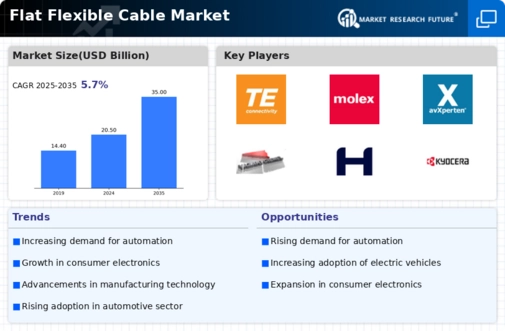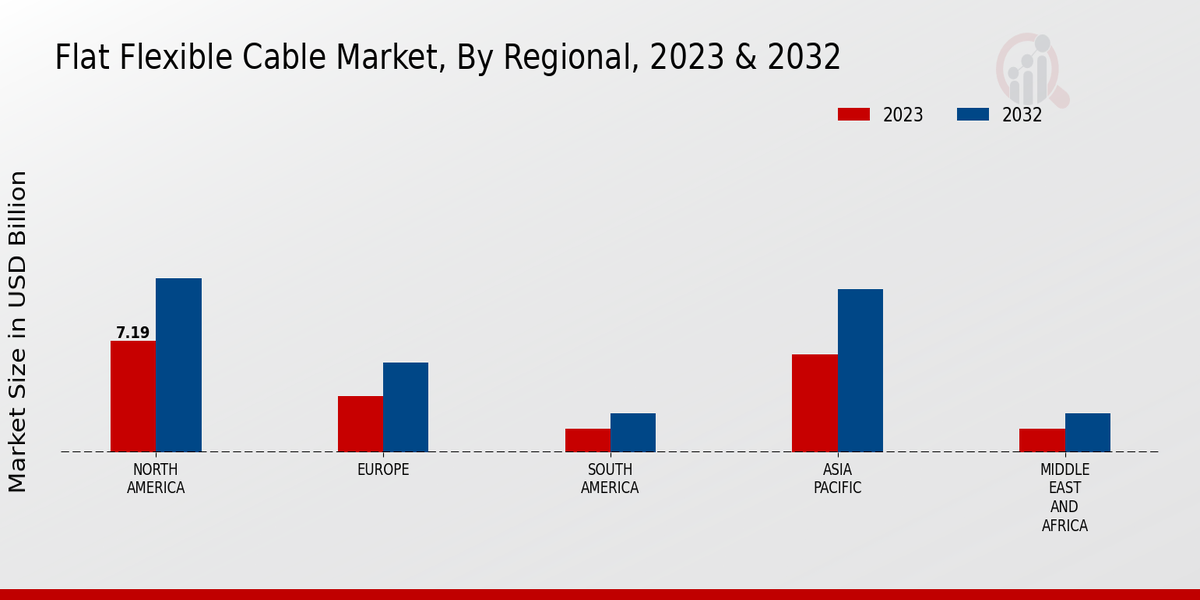Market Growth Charts
Technological Advancements
Technological advancements play a crucial role in shaping the Global Flat Flexible Cable Market Industry. Innovations in materials and manufacturing processes have led to the development of high-performance flat flexible cables that offer enhanced durability and flexibility. These advancements are particularly relevant in industries such as telecommunications and medical devices, where reliability is paramount. The anticipated compound annual growth rate of 4.95% from 2025 to 2035 indicates that the market will likely benefit from ongoing technological improvements. As industries increasingly seek efficient and reliable wiring solutions, the demand for advanced flat flexible cables is expected to grow, further solidifying their importance in various applications.
Growth in Automotive Applications
The Global Flat Flexible Cable Market Industry is significantly influenced by the automotive sector, where the demand for lightweight and flexible wiring solutions is on the rise. With the automotive industry increasingly integrating advanced technologies such as infotainment systems and electric vehicle components, flat flexible cables are becoming essential. The market is projected to reach 35.0 USD Billion by 2035, indicating a robust growth trajectory. The shift towards electric vehicles, which often require more complex wiring systems, further emphasizes the need for flat flexible cables. This trend suggests that the automotive sector will continue to be a major driver of growth in the flat flexible cable market.
Rising Demand in Consumer Electronics
The Global Flat Flexible Cable Market Industry experiences a surge in demand driven by the increasing adoption of consumer electronics. Devices such as smartphones, tablets, and laptops require efficient and compact wiring solutions, which flat flexible cables provide. As the industry anticipates a market value of 20.5 USD Billion in 2024, this trend is expected to continue. The compact design of flat flexible cables allows for space-saving applications, making them ideal for modern electronic devices. Furthermore, the growing trend of miniaturization in electronics is likely to further propel the demand for flat flexible cables, ensuring their pivotal role in the consumer electronics sector.
Emerging Markets and Industrial Growth
Emerging markets are becoming increasingly important for the Global Flat Flexible Cable Market Industry. As countries in Asia-Pacific and Latin America experience rapid industrialization, the demand for flat flexible cables is expected to rise. Industries such as manufacturing, automation, and renewable energy are adopting flat flexible cables for their versatility and efficiency. The growth of these sectors is likely to contribute to the overall market expansion, with projections indicating a market value of 20.5 USD Billion in 2024. This trend suggests that as emerging markets continue to develop, they will play a crucial role in driving the demand for flat flexible cables.
Expansion of the Telecommunications Sector
The Global Flat Flexible Cable Market Industry is experiencing growth due to the expansion of the telecommunications sector. With the increasing demand for high-speed internet and advanced communication technologies, flat flexible cables are essential for efficient data transmission. The rise of 5G technology and the need for robust infrastructure to support it are driving the demand for flat flexible cables. As telecommunications companies invest in upgrading their networks, the market for flat flexible cables is likely to expand. This trend indicates that the telecommunications sector will remain a vital contributor to the overall growth of the flat flexible cable market in the coming years.






















